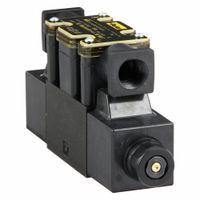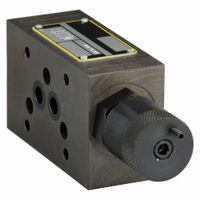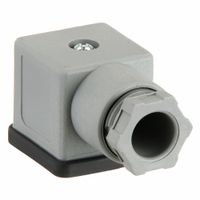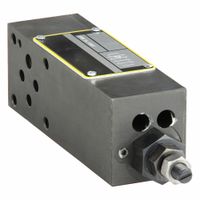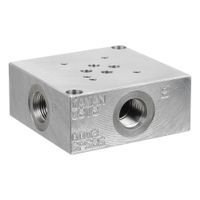Call +(254) 703 030 000 / 751 483 999 / 721 704 777
- Home
- Hydraulics
- Hydraulic Valves Flow Control
- Hydraulic Manifold Valves
.....Read More
Frequently Asked Questions
What is a hydraulic manifold valve and how does it work?
A hydraulic manifold valve is a component in hydraulic systems that directs the flow of fluid between pumps, actuators, and other components. It acts as a central hub, allowing for the control and distribution of hydraulic fluid to various parts of the system. The manifold consists of a block, typically made of metal, with multiple ports and channels that connect to different hydraulic lines.
The primary function of a hydraulic manifold valve is to manage the flow and pressure of hydraulic fluid, enabling the system to perform tasks such as lifting, pressing, or moving loads. It achieves this by integrating various types of valves, such as directional control valves, pressure relief valves, and flow control valves, into a single unit. These valves can be manually operated, electrically controlled, or automatically actuated, depending on the system's requirements.
The operation of a hydraulic manifold valve involves the following steps:
1. **Fluid Entry**: Hydraulic fluid enters the manifold through an inlet port, typically connected to a pump.
2. **Flow Direction**: Directional control valves within the manifold determine the path of the fluid, directing it to specific actuators or components.
3. **Pressure Regulation**: Pressure relief valves ensure that the system operates within safe pressure limits by diverting excess fluid back to the reservoir.
4. **Flow Control**: Flow control valves adjust the rate of fluid flow, allowing for precise control of actuator speed and movement.
5. **Fluid Exit**: The fluid exits the manifold through outlet ports, reaching the designated actuators or returning to the reservoir.
By consolidating multiple functions into a single unit, hydraulic manifold valves enhance system efficiency, reduce the need for extensive piping, and simplify maintenance. They are crucial in applications ranging from industrial machinery to mobile equipment, where precise control of hydraulic power is essential.
How do you select the right hydraulic manifold valve for a specific application?
To select the right hydraulic manifold valve for a specific application, consider the following factors:
1. **System Requirements**: Determine the flow rate, pressure, and temperature requirements of your hydraulic system. Ensure the valve can handle these specifications.
2. **Valve Type**: Choose the appropriate type of valve (e.g., directional control, pressure control, flow control) based on the function it needs to perform in the system.
3. **Port Size and Configuration**: Match the port size and configuration of the valve to the existing hydraulic lines and components to ensure compatibility and efficient flow.
4. **Material Compatibility**: Select a valve made from materials that are compatible with the hydraulic fluid and the operating environment to prevent corrosion and wear.
5. **Mounting Style**: Consider the mounting style (e.g., subplate, sandwich, or cartridge) that best fits the design and space constraints of your system.
6. **Response Time**: Evaluate the response time of the valve to ensure it meets the dynamic requirements of the application.
7. **Control Method**: Decide on the control method (e.g., manual, electric, hydraulic, or pneumatic) that aligns with the system's control architecture.
8. **Reliability and Durability**: Choose a valve with a proven track record for reliability and durability, especially in demanding applications.
9. **Cost and Availability**: Consider the cost of the valve and its availability, balancing budget constraints with performance needs.
10. **Manufacturer Support**: Opt for valves from reputable manufacturers that offer technical support and warranty services.
11. **Compliance and Standards**: Ensure the valve complies with relevant industry standards and regulations for safety and performance.
By carefully evaluating these factors, you can select a hydraulic manifold valve that optimally meets the specific needs of your application.
What are the common types of hydraulic manifold valves and their functions?
Common types of hydraulic manifold valves include:
1. **Directional Control Valves**: These valves control the path of fluid flow within the hydraulic system. They can be two-way, three-way, or four-way, depending on the number of flow paths they control. Their primary function is to direct the fluid to different parts of the system, enabling the operation of various actuators.
2. **Pressure Control Valves**: These valves regulate the pressure within the hydraulic system to ensure it remains within safe and efficient operating limits. Types include relief valves, which prevent excessive pressure by diverting fluid when pressure exceeds a set limit, and pressure-reducing valves, which maintain a lower pressure in a specific part of the system.
3. **Flow Control Valves**: These valves manage the flow rate of the hydraulic fluid, affecting the speed of actuators. They can be fixed or adjustable, allowing for precise control over the movement of hydraulic components.
4. **Check Valves**: These are one-way valves that allow fluid to flow in one direction only, preventing backflow. They are essential for maintaining the correct flow direction and ensuring system stability.
5. **Proportional Valves**: These valves provide variable control over flow and pressure, allowing for more precise and smooth operation of hydraulic systems. They are often used in applications requiring fine control.
6. **Cartridge Valves**: These are compact, modular valves that can be easily integrated into a manifold. They perform various functions, including directional, pressure, and flow control, and are valued for their flexibility and ease of maintenance.
Each type of valve plays a crucial role in ensuring the hydraulic system operates efficiently, safely, and effectively, by controlling the direction, pressure, and flow of the hydraulic fluid.
How do you troubleshoot issues with hydraulic manifold valves?
To troubleshoot issues with hydraulic manifold valves, follow these steps:
1. **Visual Inspection**: Check for visible signs of damage, leaks, or wear on the manifold, valves, and connections. Look for oil stains, cracks, or loose fittings.
2. **Check Fluid Levels and Quality**: Ensure hydraulic fluid is at the correct level and is clean. Contaminated or low fluid can cause malfunction.
3. **Listen for Unusual Noises**: Operate the system and listen for abnormal sounds like hissing, knocking, or grinding, which can indicate internal issues.
4. **Test Pressure Levels**: Use a pressure gauge to measure the system's pressure. Compare readings with manufacturer specifications to identify discrepancies.
5. **Inspect for Blockages**: Remove and inspect valves for blockages or debris that could impede flow. Clean or replace components as necessary.
6. **Examine Electrical Connections**: For electrically operated valves, check wiring and connections for damage or corrosion. Ensure solenoids are receiving power.
7. **Check for Sticking Valves**: Manually operate valves to ensure they move freely. Sticking can be caused by dirt, corrosion, or mechanical failure.
8. **Review System Configuration**: Ensure the manifold and valves are configured correctly according to the system design and application requirements.
9. **Consult Documentation**: Refer to the manufacturer's manual for specific troubleshooting guidelines and specifications.
10. **Perform Functional Tests**: Conduct tests to verify the operation of each valve. This may involve simulating different operating conditions.
11. **Replace Faulty Components**: If a valve or manifold is identified as faulty, replace it with a new or refurbished part.
12. **Seek Expert Assistance**: If issues persist, consult a hydraulic specialist or the equipment manufacturer for advanced diagnostics and repair.
What are the benefits of using hydraulic manifold valves in a system?
Hydraulic manifold valves offer several benefits in a system:
1. **Space Efficiency**: By integrating multiple valves into a single block, hydraulic manifolds reduce the need for extensive piping and separate valve installations, saving space and simplifying system design.
2. **Reduced Leakage**: Fewer connections and joints mean a lower risk of leaks, enhancing system reliability and reducing maintenance needs.
3. **Simplified Maintenance**: Centralized valve arrangements make it easier to access and service components, minimizing downtime and maintenance costs.
4. **Improved System Performance**: Manifolds allow for precise control of fluid flow and pressure, enhancing the overall efficiency and responsiveness of the hydraulic system.
5. **Customization and Flexibility**: Manifolds can be custom-designed to meet specific system requirements, allowing for tailored solutions that can be easily modified or expanded.
6. **Cost-Effectiveness**: By reducing the need for extensive piping and fittings, manifolds can lower material and labor costs during installation.
7. **Enhanced Safety**: With fewer potential points of failure and a more organized layout, manifolds contribute to safer system operation.
8. **Streamlined Design**: Manifolds contribute to a cleaner, more organized system layout, which can be crucial in complex machinery or confined spaces.
9. **Reduced Weight**: By consolidating components, manifolds can reduce the overall weight of the hydraulic system, which is beneficial in mobile applications.
10. **Noise Reduction**: The compact design and reduced number of connections can help minimize vibration and noise, leading to quieter operation.
Overall, hydraulic manifold valves enhance the efficiency, reliability, and safety of hydraulic systems while offering cost and space savings.
How do you maintain and service hydraulic manifold valves?
To maintain and service hydraulic manifold valves, follow these steps:
1. **Regular Inspection**: Conduct routine visual inspections for leaks, corrosion, or physical damage. Check for loose fittings and ensure all connections are secure.
2. **Cleanliness**: Keep the manifold and surrounding area clean. Use lint-free cloths to wipe away dirt and debris. Ensure the hydraulic fluid is clean and free from contaminants.
3. **Fluid Levels and Quality**: Regularly check hydraulic fluid levels and quality. Replace fluid if it appears cloudy or contaminated. Use the manufacturer-recommended fluid type.
4. **Filter Maintenance**: Replace or clean filters as per the manufacturer's schedule to prevent contamination and ensure efficient operation.
5. **Check for Leaks**: Inspect for any signs of leaks around the valves and connections. Tighten fittings if necessary, but avoid over-tightening.
6. **Valve Functionality**: Test the operation of each valve to ensure they open and close smoothly. Listen for unusual noises that may indicate wear or damage.
7. **Seal Inspection**: Check seals for wear or damage. Replace any worn or damaged seals to prevent leaks and maintain pressure.
8. **Torque Settings**: Verify that all bolts and fittings are torqued to the manufacturer's specifications to prevent leaks and ensure proper operation.
9. **Calibration**: Periodically calibrate valves to ensure they are operating within specified parameters.
10. **Documentation**: Keep detailed records of maintenance activities, including inspections, fluid changes, and any parts replaced. This helps in tracking performance and scheduling future maintenance.
11. **Professional Servicing**: Engage professional services for complex issues or if the system requires specialized tools or expertise beyond routine maintenance.
By following these steps, you can ensure the longevity and efficient operation of hydraulic manifold valves.
What are the key differences between hydraulic directional, flow control, and pressure control manifold valves?
Hydraulic manifold valves are crucial components in hydraulic systems, each serving distinct functions: directional, flow control, and pressure control.
**Directional Control Valves:**
These valves manage the path of fluid within the hydraulic system. They determine the direction in which the fluid flows, thus controlling the movement of actuators like cylinders or motors. Directional control valves can be two-way, three-way, or four-way, depending on the number of ports and flow paths. They are often operated manually, electrically, or hydraulically, and are essential for starting, stopping, and changing the direction of fluid flow.
**Flow Control Valves:**
Flow control valves regulate the rate of fluid flow in the system. By adjusting the flow rate, these valves control the speed of actuators. They are crucial for applications requiring precise speed control and are often used in conjunction with directional control valves. Flow control can be achieved through various designs, such as needle valves or orifice plates, and can be pressure-compensated to maintain consistent flow despite pressure variations.
**Pressure Control Valves:**
These valves maintain and regulate the pressure within the hydraulic system. They ensure that the system operates within safe pressure limits, protecting components from damage due to excessive pressure. Types include relief valves, which release excess pressure, and reducing valves, which lower pressure to a desired level. Pressure control valves are vital for system safety and efficiency, preventing pressure spikes and ensuring consistent operation.
In summary, directional control valves manage flow paths, flow control valves adjust flow rates, and pressure control valves regulate system pressure, each playing a distinct role in the efficient and safe operation of hydraulic systems.
